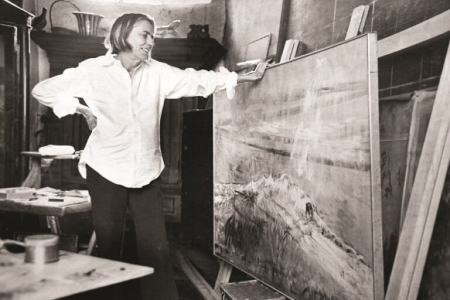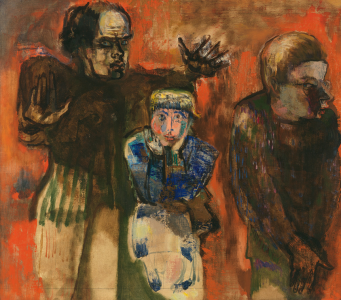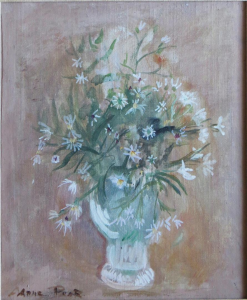
Biography
Anne Poor's mother first worked a journalist. Her father, a painter, was her mother's second husband. After Anne's birth her mother became a very successful novelist, writing under the name Bessie Breuer (Otho Breuer having been her first husband). When Anne was 7, her mother married again, this time to the well-known artist Henry Varnum Poor. He was both an artist and an architect, having many artistic commissions and designing a number of houses.
Encouraged by her stepfather, Anne studied at the Art Students League while still in high school (1935). From 1936-1938 she attended Bennington College, taking advantage of Bennington's travel program to go to Paris, where she studied at the Académie Julian and the École Fernand Léger. During this time she met Henry Miller and Lawrence Durrell.
Anne learned the art of true fresco by working with her stepfather on murals in Washington, DC (Department of Justice, 1936 and Department of the Interior, 1939) and Penn State University (1940). With this background in mural art, she won commissions for two Post Office murals - Depew, NY (1941) and Gleason, TN (1942).
With the earnings from these commissions she took a trip to the West Coast. A landscape of hers was included in the "Artists for Victory" show at the Met in New York. Anne felt that, despite the advantages of her family's connection to the art world, she had led too cloistered a life and she longed to see more of the wider world. With this in mind she joined the Women's Army Corps, hoping to work as a war correspondent. Initially she was assigned to work as a photo-technician in Arizona, where she taught a drawing class for convalescents at the Luke Air Field base hospital. Later she was working to sketch wounded airmen arriving at Mitchel Field on Long Island. Eventually she received an overseas assignment in the Pacific Theater.
The paintings and drawing that Anne did during the war years form the core of her artistic accomplishments. In 1944 she was one of five Air Force painters exhibited at the National Gallery of Art. She won first prize in the National Army Arts Contest, and she exhibited a set of paintings and drawings entitled "Men in Flight" at Rockefeller Center. In 1945 Fortune Magazine commissioned her for an article on the Air Force Transport Command.
Following the war Henry Varnum Poor worked to set up the Skowhegan School of Painting and Sculpture. Anne joined the faculty at Skowhegan in 1947 and taught there through 1961. She remained involved with Skowhegan, serving as a board member from 1963-1983 and teaching a course on fresco in 1978. In 1948 she received the Edwin Austin Abbey Memorial Fellowship which enabled her to study in Italy and Greece. Her drawing of Greek landscapes illustrated a book published later with Henry Miller (1964).
Anne Poor completed a fresco for the vestibule of the South Solon Meeting House (up the Kennebec River from Skowhegan) in 1956. In 1957 she held a solo exhibit at the Graham Gallery in New York. She won Altman prizes from the National Academy of Design in 1971, 1981 and 1987 and was elected to the American Academy of Arts and Letters in 1987. She had a solo show at Terry Dintenfass in 1992 and a show at the Edward Hopper House Art Center in Nyack, NY just a year before her death in 2002.
On a personal level, Anne Poor was a very interesting individual. She made repeated bold gestures. Her enlistment with the WACs was one, and she made what seems to have been a solo trip to the Soviet Union in 1965. She described herself as opionionated, cantankerous and outspoken. A touching tribute by Paul Resika hints at the idea that Poor regretted that she had never quite achieved all that she wanted or all that she might have been capable of.



Critical Analysis
Although Poor studied briefly at the École Fernand Léger, Léger was definitely not her cup of tea. Rather her early work was much more in the spirit of Renaissance art. The composition of her Depew, NY Post Office mural, for example, has been compared with the work of Piero della Francesca. And the poses and even the architectural features of her work were reminiscent of Renaissance painting. This work was praised for its masterful composition and it subtle use of light.
Poor's postwar work moved from the taut urgency of her wartime drawings to a more relaxed view of landscapes, still lifes and interiors. Acknowledged influences included Loren MacIver and Odilon Redon.
Murals
- Depew, New York - Post Office: Beginning of the Day
- Gleason, Tennessee - Post Office: Gleason Agriculture
References
- Abraham Storer, An Artistic Sisterhood With No Apology, Provincetown Independent March 15 (2023). Article on Anne Poor's daughter Anna.
- Anne Poor (National Academy of Design).
- Sylvia Moore, Anne Poor, Women's Art Journal Vol. 2 No. 2 (Autumn, 1981 - Winter, 1982) (1981).
- Anne Poor (Anne Poor).
- Anne Poor (1918-2002) (Burchfield Penney Art Center).
- Joanne B. Mulcahy, Marion Greenwood and Anne Poor: The Women Artists of the WWII Art Program, Hyperallergic June 4 (2019).
- Tribute to Anne Poor (Arts and Letters). by Paul Resika.